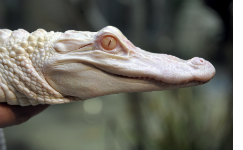
Judy Natal agrees with my previous, but she adds:
But what really interested me was that little quirky ending of the film about a environmental pocket of white albino alligators and alien worlds formed by run off from a nearby nuclear power plant...Any way to connect the dots there?
Yes I think so. For a kick off, it's a sign of the times that a Romantic such as Herzog can't stick with a self-contained, though open in the sense of self-reflexive, narrative-that-includes-the-narrator (the standard Romantic form). Suddenly there is a coda, something after this Romanticism.
I've been arguing for a fourth aesthetic moment, extending Hegel's periodization of art by imagining what ecological art is: the point of contact with nonhumans, the moment at which nonhumans enter human language in a decisive way. I'm not meaning to say Hegel's model is correct. It's more like Hegel, as a product of the modernity we are living, speaks (and can't speak) about some of the issues in a way that's quite congruent with how we think about them.
What we have in Hegel's white western periodization are three moments:
1) Symbolic. Art's substance (statues, instruments, paint) outstrips its content. Fetishism.
2) Classical. A Goldilocks harmony between substance and content. Symmetry. Bach, Mozart.
3) Romantic. Art's content outstrips its substance. Philosophy drives ahead, art can only fail better (irony).
In the Deleuzian manner, in which we push philosophy from behind to vomit forth some unspeakable secrets, we can imagine a fourth moment, which I call a time of asymmetry:
4) Ecological. Art's content outstrips its substance in one way: we know way more every day about reality (science). But the substance of art outstrips the content (revenge of the objects). An asymmetrical confrontation between the human and the nonhuman.
Moment 4 is like moment 2 in that there is equal power between substance and content. But unlike it since this equality is asymmetrical, unstable.
Moment 4 is like moment 1 in that objects such as Pollock's paint drips now free themselves from the human realm. But unlike it since humans have more knowledge.
Moment 4 is like moment 3 in that there is still irony. But unlike it since objects are no longer simply sounding boards for human subjectivity.
In Moment 4, the future future opens. A future without us. A future in which an object like radioactive waste lasts longer than the time stretching all the way back to the caves with their paintings.
A future in which evolution develops intelligent albino alligators who make their own Romantic movies about cave paintings.
Yes? That was an interesting moment wasn't it Judy?
No comments:
Post a Comment